In the world of sewing, the term “top stitch” carries both practicality and artistry within its simple definition. A top stitch refers to a visible line of stitching on the outer side of the fabric, typically positioned about 1/4 inch or more from seams and edges.
Beyond the functional purpose of reinforcing seams, edges, and design elements, top stitching is a creative endeavor, allowing for personal expression through thread selection and stitch style.
This technique not only enhances the durability of sewn items by preventing fraying but also adds an aesthetic dimension to garments, accessories, and various fabric creations.
Understanding and mastering top stitching is a key skill that elevates the craftsmanship of sewing projects.
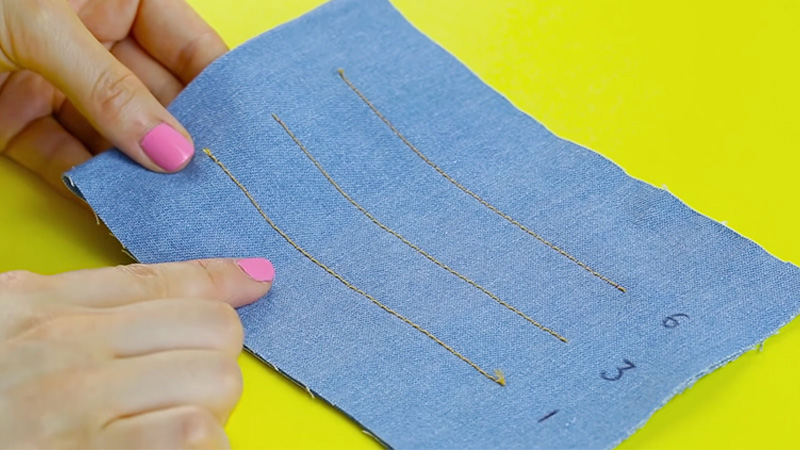
What is a Top Stitch in Sewing?
A top stitch in sewing is a visible line of stitching on the right side of the fabric, typically placed around 1/4 inch or more from the seam. It serves dual purposes: reinforcement and decoration.
This technique strengthens seams, edges, and design features, preventing fraying and enhancing durability. It also adds a decorative touch, allowing for creative expression through thread color and stitch style choices.
Commonly seen in denim jeans, top stitching is a hallmark of professionally finished sewing projects, providing both structural integrity and aesthetic appeal to garments, accessories, and various fabric creations.
What is the Purpose of Top Stitching in Sewing?
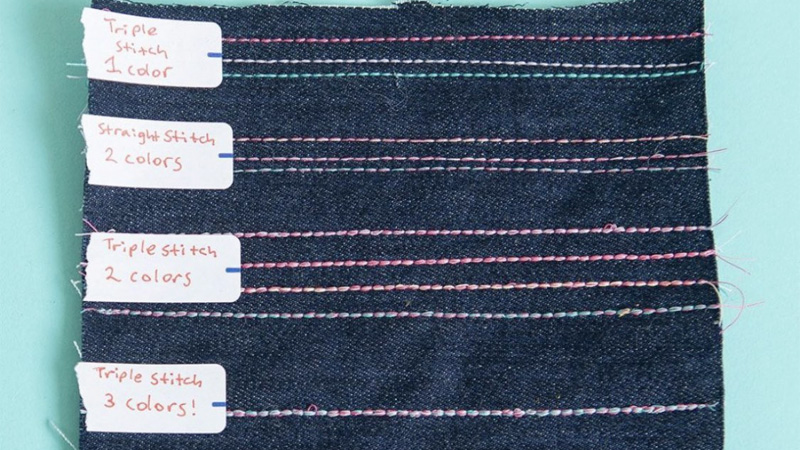
The purpose of topstitching in sewing is twofold, combining both practical and aesthetic functions to enhance the overall quality and appearance of a sewn item.
Here’s an exploration of the key purposes of topstitching:
Reinforcement
Top stitching serves as a reinforcement for seams, edges, and other areas of a sewing project. Sewing a visible line of stitches along these regions, adds strength and stability to the fabric, making it less likely to fray or unravel over time.
This reinforcement is particularly important in high-stress areas of garments, such as pockets, collars, and hems.
Durability
The presence of top stitching contributes to the longevity and durability of a sewing project. It helps maintain the integrity of seams and prevents the fabric from wearing out prematurely.
This is especially crucial in items like jeans, where top stitching along the seams adds extra strength to withstand frequent use and laundering.
Preventing Fraying
Top stitching acts as a barrier against fraying. By securing the fabric edges with visible stitches, prevents the threads of the fabric from coming apart, which can be especially beneficial for woven fabrics that are prone to fraying.
This is particularly important for the longevity of the sewn item.
Decoration
Beyond its practical applications, top stitching adds an attractive decorative element to sewing projects. The contrast between the stitching and the fabric can create visually appealing accents, enhancing the overall aesthetics of the item.
It allows for creative expression and customization, as you can choose different thread colors and stitch styles to match your design vision.
Emphasizing Design Details
Top stitching is often used to highlight specific design features or structural elements of a garment or project. It can outline the edges of pockets, cuffs, collars, or other design details, drawing attention to these areas and contributing to the overall style and functionality of the piece.
Professional Finish
Well-executed top stitching is a hallmark of a professionally finished sewing project. It gives the item a polished and refined appearance, making it look expertly crafted.
This attention to detail can elevate the overall quality of your work.
Securing Layers
In projects that involve multiple layers of fabric, interfacing, or padding, top stitching helps secure these layers together. It prevents shifting or separation and ensures that the various components of the project remain in place.
Customization
Top stitching allows for customization and personalization. You can choose the type of thread, thread color, and stitch length to achieve a specific look or style that matches your creative vision.
This level of customization adds a unique touch to your sewing projects.
Where Can I Use Top Stitching When Sewing Clothes?
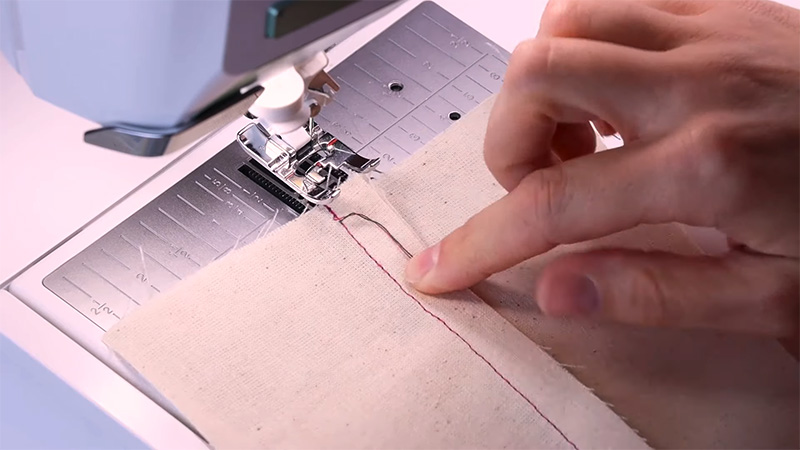
Top stitching is a versatile sewing technique that finds application in various areas when crafting garments. It reinforces seams, hems, and edges, preventing fraying and enhancing durability.
Top stitching can be employed along waistlines, princess seams, pant side seams (often the inseam), collar edges, waistband edges of skirts and pants, straps, pockets, necklines, plackets, hems, and over elastic waistbands to secure the elastic.
It also serves decorative purposes, highlighting design details, such as buttonholes, darts, and quilting. By choosing thread color and stitch style, sewers can add a unique and professional touch to their clothing projects, combining both function and fashion.
What Thread is Used for Top Stitching?
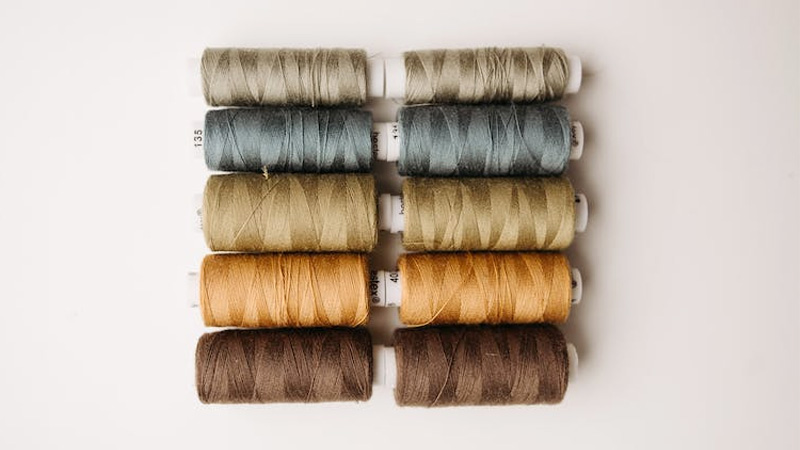
The choice of thread for topstitching is a crucial decision in sewing, as it significantly influences the overall look and durability of your project.
Here are some common types of threads used for topstitching:
All-purpose Thread
This is the standard thread used for general sewing tasks and is suitable for many top stitching applications, especially on lightweight to medium-weight fabrics.
It comes in a wide range of colors, making it versatile for various projects.
Topstitching Thread
Designed specifically for topstitching, this thread is thicker and heavier than all-purpose thread. It creates prominent and durable stitches, often featuring a subtle sheen.
Topstitching thread is ideal for adding decorative and structural elements to your sewing projects.
Heavy-duty Thread
When working with heavy or dense fabrics like denim, canvas, or upholstery materials, heavy-duty thread, such as topstitching or upholstery thread, is essential.
It provides the necessary strength and durability for top stitching on these materials.
Contrast Color Thread
Using a thread color that contrasts with the fabric can create eye-catching and decorative topstitching. For example, white or colored thread on dark denim for a classic jean-style look.
Buttonhole Twist Thread
This thicker thread is often used for reinforcing buttonholes and for creating decorative topstitching. It adds strength and a bold appearance to stitches.
Embroidery Thread
Known for its vibrant colors and sheen, embroidery thread can also be used for decorative topstitching. It adds a unique and attractive finish to projects.
Woolly Nylon Thread
Ideal for stretchy or knit fabrics, woolly nylon thread offers elasticity and a soft, comfortable finish. It’s commonly used for sportswear and lingerie.
How Can I Achieve Perfect Top Stitching With My Sewing Machine?
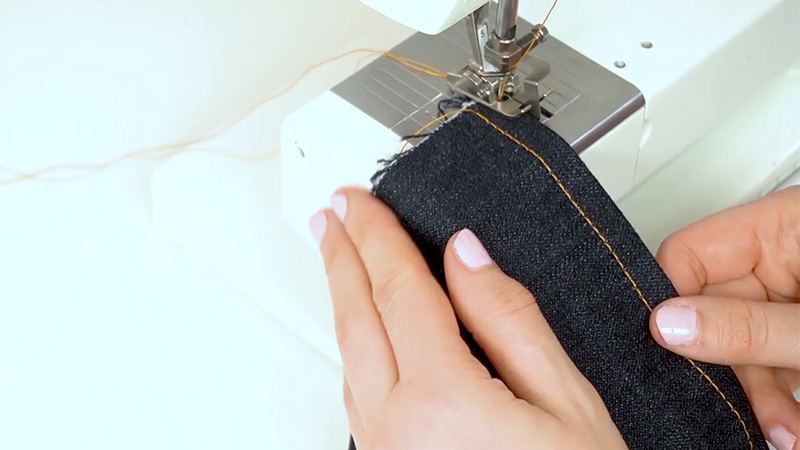
Achieving perfect top stitching with your sewing machine can elevate the quality and appearance of your sewing projects. Top stitching serves both functional and decorative purposes, reinforcing seams, preventing fraying, and enhancing the overall aesthetics of your creations.
To achieve impeccable top stitching, follow these essential steps:
Prepare the Fabric
Start with well-prepared fabric. Ensure it’s clean, pressed, and free of wrinkles. Pin or baste the layers together if necessary to prevent shifting during sewing.
Proper fabric preparation sets the foundation for clean topstitching.
Thread and Needle Selection
Choose the right thread for your project. For most top stitching, opt for a topstitching thread that complements your fabric. Match it with an appropriate needle, considering the fabric type.
Topstitching needles often have larger eyes to accommodate thicker threads.
Adjust Stitch Length
Set your sewing machine to the desired stitch length. A slightly longer stitch length than your standard seam length (around 3.0 to 3.5 mm) is often suitable for topstitching.
Test on a fabric scrap to ensure the stitch length suits your project.
Marking Guidelines
Use tailor’s chalk, removable fabric markers, or painter’s tape to mark a stitching guideline on your fabric. This line will serve as your reference to sew straight and maintain a consistent distance from the edge.
No Backstitching
Unlike regular seams, avoid backstitching at the beginning and end of your topstitching. Leave long thread tails hanging. These can be secured later by tying knots or using fabric glue.
Guiding the Fabric
As you sew, guide the fabric carefully. Keep your hands steady and follow the marked guidelines. Maintaining a consistent seam allowance and sewing straight is essential for a neat result.
Seam Allowance Guide
To ensure a consistent seam allowance, use the markings on your sewing machine’s throat plate or the edge of your presser foot as a guide. Alternatively, apply painter’s tape as a visual reference to sew the perfect distance from the edge.
Tension and Practice
Pay close attention to your sewing machine’s tension settings. Adjust as needed to prevent loose or tight stitches. Practice on scrap fabric to get a feel for your machine’s settings and to achieve the desired stitch quality.
Knot and Secure
When you’ve completed the top stitching, leave long thread tails at the beginning and end. Tie knots to secure the threads, and trim any excess threads neatly.
Patience and Practice
Perfecting top stitching may take practice. Be patient and continue experimenting with different thread types, tensions, and needles. Over time, you’ll become more adept at creating neat and even top stitches, enhancing the overall quality of your sewing projects.
FAQs
What sewing machine settings are ideal for topstitching?
The ideal sewing machine settings for topstitching include a longer stitch length (typically around 3.0 to 3.5 mm), appropriate thread tension, and a presser foot that allows for easy guiding along the fabric edge.
Can I top stitch on stretchy or knit fabrics?
Yes, you can top stitch on stretchy or knit fabrics. To prevent stretching or distortion, consider using a walking foot or a ballpoint needle designed for knit fabrics.
Are there any special techniques for top stitching around corners or curves?
When top stitching around corners or curves, it’s essential to sew slowly and pivot the fabric as needed to maintain a consistent distance from the edge.
You can also use smaller stitches in these areas for more control.
Can I use decorative stitches for top stitching?
Yes, you can use decorative stitches for top stitching to create unique and eye-catching effects. Just ensure that the chosen decorative stitch complements the fabric and project.
How do I hide or secure the thread ends in top stitching?
To secure thread ends in top stitching, leave long thread tails at the beginning and end, tie knots, and then trim any excess thread. Some sewers also use fabric glue or fray check to secure the ends discreetly.
To Recap
The concept of a top stitch in sewing transcends the mere act of stitching fabric; it represents the fusion of function and form in the world of textile crafting.
Through meticulous and precise stitching on the visible surface of the fabric, top stitching fortifies seams, edges, and design features, ensuring longevity and structural integrity.
Simultaneously, it serves as a canvas for artistic expression, enabling sewers to infuse their creations with personality and style.
Whether accentuating design elements, preventing fraying, or delivering a professional finish, the top stitch is an essential tool in the hands of anyone seeking to transform ordinary fabric into remarkable works of wearable or functional art.
It exemplifies the craftsmanship and creativity that make the world of sewing endlessly captivating and rewarding.
Leave a Reply